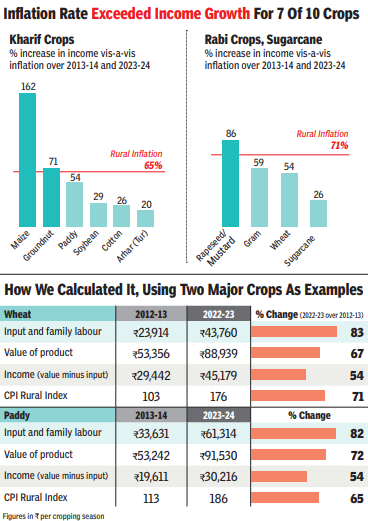Indian farmers are hit by the double whammy of stagnant income and declining profit margins, according to an analysis of data compiled by the Commission for Agricultural Costs and Prices (CACP). For nearly all major crops, the increase in agricultural income over the last decade has not kept pace with the rural inflation rate. The data also shows that the profit margins for most crops have declined. The analysis of ten major crops for both kharif and rabi seasons shows that, except for maize, groundnut and rapeseed/mustard, the increase in farm income has been less than the rural inflation rate during the same period.

Inflation rate exceeded income growth
In 2013-14, the average input cost was Rs 25,179 per hectare for paddy while the value of family labour was assessed at Rs 8,452 per hectare. The value of the crop was Rs 53,242 per hectare, which meant a profit of Rs 19,611 per hectare. In 2023-24, this profit increased to Rs 30,216 per hectare. Although this was a 54% jump, consumer prices in rural areas increased by 65% between 2013-14 and 2023-24. The crop also saw a decline in profit margins. In 2013-14, the profit margin was 58% of the input and labour costs, which has now dropped to 49.3% of the cost. The input cost and family labour is taken as the total expense to calculate the profit margin since this spending is also part of the formula for Minimum Support Price (MSP). Wheat, unlike paddy, is primarily a rabi (winter) crop, but a comparison of decadal growth in income and margins shows a similar pattern. The surplus over input cost and family labour was Rs 29,442 per hectare in 2012-13 and increased by 53% to Rs 45,179 in 2022-23. That’s lower than the 71% increase in rural consumer prices between 2012-13 and 2022-23. The profit margin too decreased from 123% in 2012-13 to 103% in 2022-23. Sugarcane, another major crop, also saw a stagnation in net income. From Rs 96,451 per hectare in 2012-13, the profits increased to 1,21,668 in 2022-23. This 26% increase is lower than the increase in consumer price inflation. In 2012-13, the profit margin was 151%, which declined to 102% in 2022-23. Of the ten major crops (based on highest output) for which the comparison is done, only three have shown an increase in income higher than the inflation rate. These are maize (162%), rapeseed & mustard (85.7%) and groundnut (71.4%). For the rest, the increase was lower than the inflation rate. It was between 50% and 60% for gram, between 20% and 30% for soyabean and cotton, and less than 20% for arhar (tur). Apart from stagnant incomes, the profit margins have declined for all of these crops except maize. These per-hectare profits are roughly equal to the seasonal incomes for a vast majority of Indian farmers. The average land holding size in the Agriculture Census of 2015-16 was just under 1.1 hectares, but most farmers (68.5%) are marginal farmers, which means they own less than 1 hectare of land (averaging at 0.38 hectare). This means that seasonal income for them will be even lower. Experts have pointed out that the stagnation as well as lower agricultural income is due to the extent of mismatch between the share of agriculture in GDP and in employment. Despite contributing only 16% of GDP, agriculture employs more than 40% of India’s workforce. In advanced economies like the US, its share in GDP and employment is 0.9% and 2%, respectively. Even in a developing economy like China, agriculture’s contribution to GDP is 6.8% while it employs 22% of the workforce.

